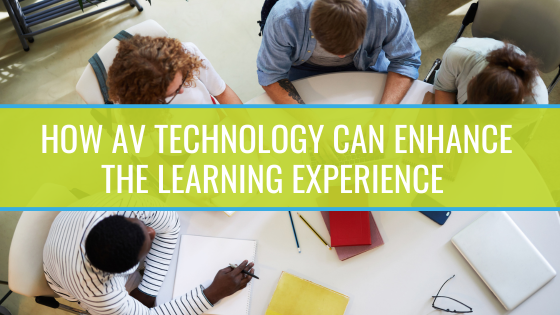Technology is a mainstay in the modern school, and AV technologies stand out for their ability to improve the learning experience. AV can be found in the classroom, in hallways, in labs, in libraries, in the gym - AV is ubiquitous in education.
Educational AV is designed to do a lot in schools, but ultimately, it's a learning multitool, facilitating and delivering lessons in a much more engaging way. Here, we'll address what makes AV an ideal fit for K-12 campuses, and the solutions that schools frequently rely on.
AV is an A+ Communicator in Schools
AV was originally built for communication, as it can support better conversations and deliver better information. This communication advantage can be leveraged by schools in a few ways, including with digital signage. Digital signage is one of AV's most versatile solutions and can serve in a few roles for schools. Some of them include:- Running morning announcements - Your school is likely already recording and playing morning announcements. With digital signage, those announcements can be piped to every room on campus, as well as hallways, common areas and visitor areas.
- Displaying important information - Event schedules, exam schedules, reminders about holidays and early dismissals, sports scores, weather, news, and all kinds of information can be shared through digital signage.
- Strengthening the student fabric - Signage layouts can also be dedicated to school spirit-boosting messaging, such as highlighting student accomplishments and providing information about little known student clubs.
- Helping people find their way - Some K-12 campuses are massive and can leave visitors and new students feeling lost. Digital signage can help point the way, which is helpful for open houses, student orientations and any event that will attract a lot of people unfamiliar with the campus.
- Deliver emergency messaging - When an emergency situation arises, the front office can send an instant emergency alert to every networked signage display. Emergency messaging can include critical information to help students and teachers respond appropriately to the situation.
Video Conferencing Can Bring in Expert Educators from Around the World
Video conferencing is another core AV communication technology, and current generation solutions are well-built for education. That's because they're designed with usability and streamlined content sharing in mind. In the classroom, video conferencing can connect students to respected experts. Artists, scholars, scientists, engineers, doctors - there are thousands and thousands of professionals out there that can also serve as guest educators. Video conferencing allows those professionals to easily connect with the classroom. It's also easy for teachers, because with a modern video conferencing solution, one tap from a connected device can launch a conference. In some instances, guest lecturers may have content - images, videos, slideshows - that they can share through the video conferencing system. Most solutions make this simple to manage, with built-in content sharing features. Here's an idea. Take a medium-sized room that's getting little use and fit it with video conferencing technology. That room can be a guest lecturer room and provide students with a novel learning experience. Consider scaling the system up a bit with a second display (or interactive flat panel). A second display makes for more interesting presentations, as the lecturer can share content to one screen while they remain visible on the other.Audio Visual Technology Makes Classroom Learning Much More Immersive
And of course, AV technology can ramp up classroom engagement. How? It starts with the room's digital display. Modern displays are powered with LED technology that's extremely efficient and reliable, so they provide long-term value. With their ability to output ultra-high-quality visuals, LED displays are a powerful visual aid and a teacher's best friend. But interactive flat panels can take this approach a step further. These flat panels can also output brilliant visuals and serve as a constant classroom companion for teachers. They can also improve engagement by incorporating tactile learning into the lesson. For students who would rather use their hands to do the learning, interactive flat panels can be an effective way to drive student participation. Interactive displays like the Clevertouch also improve lesson flow for teachers. Educators can connect their own devices to the display, and once connected control it from their device. This allows teachers to keep the lesson going without breaking eye contact with students.Better Classroom Audio Can Also Keep Students Focused and Engaged
Another way to enhance classroom learning? Enhance classroom audio. Poor audio is a common problem in low-engagement classrooms. In larger classrooms or in classrooms with uncooperative acoustics, poor audio can be severe, leading to significant information gaps as students strain to hear. And many of those students will tune out instead. Unsurprisingly, audio enhancement is a popular AV solution for K-12 schools. It's also an easy solution for AV integrators to implement. Some of the standout features and benefits of audio enhancement include:- Improved audio quality and distribution - Audio enhancement uses a microphone and speakers to distribute crisp audio throughout the room. No matter where students are sitting, they can hear the teacher as if they were in the front row.
- Reduced voice strain - Most audio enhancement technologies utilize a worn microphone, so teachers can use their hands freely while speaking into one. And teachers can use their normal speaking voice when lecturing or interacting with students, as the technology does the heavy lifting. No need to strain your voice.
- Two-way communication - Some audio enhancement solutions allow for two-way communication with the front office, so teachers don't have to leave their classroom and rush to the office if something important comes up.
- Emergency alerts - Audio enhancement technology can also factor into the school's emergency response protocols. Specifically, some systems allow teachers to send an alert to the front office or trigger a general alarm with a single button press.



